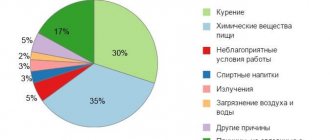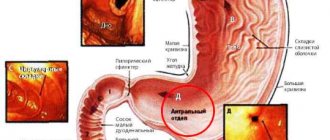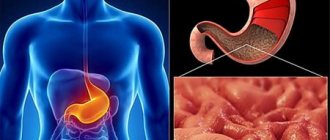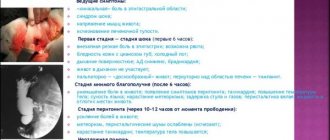Children's susceptibility to disease
Clogging in a child under 2 years of age is most often the result of infectious diseases, disorders of the digestive system and problems with blood supply. Sometimes symptoms of the disease appear as a complication of stomach flu, which can lead to inflammatory damage to the organ mucosa.
Identifying a blockage in a young child can be very difficult because the child is not able to describe the symptoms. To do this, you need to palpate the abdomen and identify painful areas. Then the doctor listens to these places using a stethoscope.
To diagnose this disorder in a child, you need to take an x-ray of the abdominal cavity using a contrast agent. Thanks to this, you can see the level of patency of the organ and identify gallstones in the duct.
What are the types of intestinal obstruction?
There are different classifications of intestinal obstruction:
| Depending on the reason | Mechanical - divided into three types:
Dynamic intestinal obstruction occurs as a result of persistent spasm or paresis (relaxation) of the intestinal wall. |
| Depending on the level |
|
| Depending on the speed of occurrence |
|
| Depending on the degree of intestinal obstruction |
|
According to statistics, if timely medical care is not provided, with acute intestinal obstruction, up to 90% of patients die within 4–6 hours. Therefore, it is important for the patient to know the first symptoms of this condition and, if they occur, to immediately consult a doctor.
Signs of a problem
Symptoms of stomach clogging are not specific and can relate to various pathologies of the digestive system - for example, acute gastritis. Therefore, only instrumental diagnostics will help make a diagnosis.
The main signs of the disease include the following:
- Vomiting with bile impurities. It is a consequence of the fact that the body tries to remove food by any means.
- Symptoms of dehydration. This condition is a consequence of frequent vomiting.
- Rapid onset of feeling weak or tired.
- Nausea.
- Flatulence.
- Severe pain syndrome of paroxysmal nature.
- Diarrhea. This symptom is common when there is not too serious damage. With severe lesions, on the contrary, constipation appears.
- Bloody impurities in the stool.
- Temperature increase.
- Loss of appetite.
When blood appears in the vomit or stool, we can talk about the onset of internal bleeding. If you have such symptoms, you should immediately consult a doctor.
If the stomach is clogged, an x-ray with contrast is recommended.
Symptoms of the disease
Currently, more and more people are faced with various disorders in the functioning of the digestive system. This is caused by eating disorders, stressful situations, and bad habits. One of the dangerous problems is stomach clogging. If you do not consult a specialist in time, there is a risk of developing dangerous complications.
Symptoms of stomach blockage depend on several factors such as:
- causes of the pathological process;
- degree of damage to the body by infection;
- the presence or absence of malignant neoplasms;
- location of the affected part;
- individual characteristics of the body.
Despite the different reasons that can cause gastric obstruction, the signs of the pathology are similar:
- constant heaviness in the upper abdomen, accompanied by belching;
- frequent vomiting of undigested food;
- the patient loses weight.
Atresia
Atresia is characterized by a complete lack of movement of food from the stomach. In newborns, obstruction is characterized by:
- repeated vomiting with no signs of bile in the vomit;
- rapid dehydration;
- a gradual decrease in meconium (feces of a newborn) until the complete absence of stool.
Diagnosis of stomach pathology
To clarify the diagnosis of gastric obstruction, several methods are used.
They start as usual with a conversation, visual inspection, then palpation and listening to the abdomen.
Laboratory examinations of blood, urine, gastric contents and feces are prescribed.
To complete the examination you need:
- Ultrasound of the abdominal organs makes it possible to assess the size of an enlarged stomach.
- A more complete picture is provided by fluoroscopy and radiography with a contrast agent. The method allows you to determine the size of the stomach, whether there is a narrowing of the canal, and how long it takes for the food mass to be evacuated from the organ.
- Esophagogastroscopy - using a probe and a miniature video camera, the internal condition of the walls of the stomach is examined, the size and presence of deformations of the organ can be determined. Also, if a tumor is suspected, it is possible to take tissue for histological analysis.
- Electrogastroenterography – gives an idea of the motor function of the stomach and its electrical activity.
Based on the examination results, the doctor determines the diagnosis and prescribes treatment.
How to treat
Treatment of blockage can be carried out either surgically in severe cases or conservatively in the hospital, however, at home in case of acute symptoms the following measures can be carried out:
- rinse the stomach by inducing vomiting with water or using castor oil;
- take Regidron 1 teaspoon every 10 minutes for several hours;
- drink Mezim forte, Festal or other enzyme preparations in the amount of 2 tablets for an adult and 1 for a child;
- drink mineral water at room temperature in small sips, but often;
- limit the consumption of fatty, fried and other foods that require significant time and resources to digest;
- As a folk recipe, you can use a decoction of chamomile or sage to relieve acute inflammatory processes.
Conservative treatment with hospitalization involves enemas and gastric lavage, as well as the appointment of special droppers to restore water and electrolyte balance, if necessary.
In some cases, a catheter is installed to balance the amount of fluid in the body.
If the desired effect is not achieved, surgical treatment is performed.
Using an endoscope, excess fluid is pumped out from the stomach, then, if tissue necrosis has begun, the doctor removes the dead area of the stomach.
After the operation, symptoms of dehydration are eliminated and water and electrolyte balance is restored.
Unfortunately, there are no medications that can independently remove the blockage, so medications are mainly prescribed after surgery to improve the patient’s general well-being.
In general, antibiotics are prescribed to stop the infection, painkillers for severe pain, and anti-emetic medications.
Before taking any medications, consult your doctor yourself.
Treatment of pathology can be carried out using the following methods:
- Conservative therapy - in this case, enemas and gastric lavage are prescribed. The doctor may also prescribe IVs using a special solution. This helps restore normal electrolyte balance. In some cases, catheterization is indicated to help determine fluid balance.
- Surgical intervention - during this procedure, excess fluid is removed from the stomach with a flexible tube, after which, if necessary, tissue that has undergone necrosis is removed. The healthy organ fragments are then joined together. Within 6-8 hours after surgery, dehydration should be eliminated and water and electrolyte balance should be restored.
Conservative therapy is indicated in cases of not very serious injuries. In this case, surgical intervention is required in severe stages of the disease.
If symptoms of clogging appear, doctors advise following these recommendations:
- rinse the stomach in any available way;
- take rehydron every 5-10 minutes - you need to do this for 2-3 hours;
- take mezim, festal or other enzyme preparation;
- drink warm water in small sips;
- remove difficult-to-digest foods from the menu;
- drink chamomile decoction to stop the inflammatory process.
At the slightest suspicion of gastric obstruction, you should urgently seek medical help. The patient is placed in a hospital, where, after an examination, appropriate therapy is prescribed, most often this is an emergency operation.
- Conservative treatment of gastric obstruction is not practiced, except for minor blockages.
- Under the supervision of a doctor, using instrumental diagnostic methods, gastric lavage can be performed in a hospital setting.
- But more often it is still an operation.
First aid at home is not recommended, even if the development of symptoms is slow. The independent use of symptomatic medications is even more dangerous.
Symptoms and treatment of gastric obstruction
Gastric obstruction is a syndrome that is characterized by a complete or partial disruption of the movement of food products and all contents through the digestive tract.
The digested substance simply cannot enter the intestines and lingers in the body, thereby causing pain.
According to the nature of development, mechanical and dynamic obstruction is distinguished, which is caused by 2 factors:
- mechanical obstruction inside the organ;
- violation of the motor function of the organ.
There are also acute and chronic forms of obstruction.
Reasons for development
The main reasons for the development of obstruction from the stomach to the intestines include:
- infectious/inflammatory processes in the intestines/stomach;
- neoplasms that develop as a result of cancer of the gastrointestinal tract, regardless of their nature and the nature of the cancer;
- narrowing of the exit section of the internal organ. Most often, this condition is provoked by an intestinal ulcer;
- eating inedible, hard, large objects that cannot be digested and absorbed by the body;
- intestinal atresia (a condition in which natural channels and openings in the body become overgrown or absent from birth);
- coprostasis (clogging of the hernia, closure of the intestinal loop with feces);
- intussusception (a disease in which one part of the intestine invades the lumen of another);
- gastrointestinal tuberculosis;
- formation of adhesions;
- esophageal diverticulum;
- disturbances of normal blood circulation in the body (occurs when organs protrude/herniation);
- the presence of foreign bodies in the stomach/intestines;
- formation of fistulas (fistulas).
Symptoms
Symptoms of the disease are ambiguous and depend on the following factors:
- nature of the disease;
- the degree of damage to the body by infection;
- localization of the affected organ;
- individual patient indicators;
- presence of cancer, oncological pathologies.
The main symptoms appear as follows:
- nausea/vomiting (in case of cancer, vomit contains blood clots, a large amount of mucous matter, and emits a rotten odor);
- unpleasant odor from the mouth during belching;
- a sharp decrease in body weight;
- constant feeling of oversaturation;
- discomfort, pain in the intestinal area;
- intense spasmodic pain in the abdomen;
- retention of stool and gases;
- intoxication;
- asymmetrical bloating;
- relaxation of the anal sphincter;
- sudden uncontrolled tension in the abdominal wall;
- accumulation of gas in the colon;
- bloody feces;
- the sound of splashing over the intestines.
Pyloric stenosis
Pyloric stenosis is the name given to obstruction of a certain part of the stomach (pyloric), which occurs as a complication of gastric ulcer.
The ulcer becomes scarred, the internal organ becomes deformed, and the stomach cavity narrows (a special channel through which, using diagnostics, the level of obstruction is determined). The lumen of the stomach is closed by membrane tissue.
This tissue has an uneven structure, covered with small holes of different sizes (the gaps can be more than half the size of the membrane).
The membrane located in the pyloric canal consists of a thin mucous membrane, submucosal coating, and fragments of muscle tissue. In the absence of proper treatment, the membrane increases in size (the wall thickens) and becomes identical to the tissues that make up the walls of the stomach.
The symptoms of pyloric stenosis are no different from those of an ulcer. The pain does not affect the general condition of the patient; it is spasmodic in nature and of low intensity.
Rare attacks of nausea or vomiting are attributed to eating poor quality food or overeating. You should pay attention to the composition and smell of the vomit.
It has a specific acidic taste and large mucous secretions.
Normalization of patency with pyloric stenosis occurs with the help of probing, pumping out contents from the internal organ that have undergone oxidation. The patient is prescribed systematic gastric lavage. After such manipulations, the patient’s condition improves. In the absence of medical manipulations, the following occurs:
- increased inflammation;
- decreased tone in the muscle tissues of internal organs;
- sudden weight loss;
- distension of the normal size of the stomach;
- manifestation of profuse vomiting;
- development of atony;
- dehydration;
- general exhaustion of the body;
- metabolic disease;
- constipation
Classification
Classification according to functional characteristics:
- Dynamic obstruction. Impairment of intestinal motor function, which is not provoked by mechanical stress. Reasons: decreased muscle tone/sharp increase in muscle tone.
- Mechanical obstruction. Impaired movement of food mass, the causes of which are: volvulus, organ strangulation, mechanical obstruction (gallstones, fistulas, feces, helminths, foreign bodies), tumor, cyst.
- Mixed type. Characterized by intussusception and the formation of adhesions.
First aid
In the initial stages of the disease, there is no need for pre-medical care, since there are no pronounced symptoms. The only form of assistance is to assist during vomiting.
Ensure compliance with sanitary and hygienic standards.
After the patient has been brought into adequate condition and the vomiting has stopped, the person should be sent for inpatient treatment to the nearest medical center.
Treatment
After an accurate diagnosis of the disease, the patient is urgently hospitalized in a surgical hospital. The operation is expected to be carried out immediately (as already stated, with each passing hour the body is exposed to more intense pathogenic effects). Before proceeding with surgery, the patient undergoes special training, which takes up to 4 hours.
If the diagnosis is not established or is not definitively established, treatment consists of conservative (medicinal) methods and additional diagnostics of the patient’s condition.
Conservative therapy
Enema technique.
Conservative treatment is aimed at:
- providing an analgesic effect;
- normalization of the processes of self-regulation of organisms;
- additional protection against cancer of affected organs;
- freeing the digestive tract from remnants of stagnation (undigested food).
Treatment consists of taking medications prescribed by your doctor, following a strict diet, and normalizing physical activity. An additional method of cleansing the body is enemas. After conservative treatment, the patient’s condition should improve, and the symptoms should dull or disappear:
- Abdominal pain will disappear;
- the feeling of nausea/vomiting will stop;
- the passage of feces and gases is normalized;
- bloating will disappear;
- removal of stagnant substances from the body;
- the functionality of the gastrointestinal tract is normalized.
After proper conservative therapy, the patient will not require surgery.
Surgery
Surgery is indicated only in cases where conservative treatment has not produced any results.
An additional factor that influences the time frame for the operation is the current condition of the patient (symptoms of the disease, the patient's condition, which may be life-threatening).
In some cases, there is no time to carry out therapeutic measures, since this threatens the death of the patient.
Diet
Patients with gastric obstruction should adhere to a special diet to quickly normalize the body’s condition and avoid relapses of the disease. A person should change their own diet and switch to healthy foods:
- Organize split meals in small portions every 2-3 hours. On average, this amounts to 5-6 meals per day.
- Refusal to eat fatty, carbohydrate, smoked, seasoned, pickled foods. It is recommended to eat food that has undergone minimal heat treatment.
- Use of vitamin complexes/biological supplements.
- Increase your consumption of fruits and vegetables.
- Increase your protein intake.
Possible complications/consequences
Poor cross-country ability is fraught with the following:
- death;
- the patient's state of shock (requires additional medical measures);
- formation of paralytic obstruction;
- severe pain syndrome;
- development of additional oncological and infectious diseases;
- movement restrictions;
- deterioration of the body's condition;
- destruction of internal microflora, inhibition of the protective function of the immune system, its weakening.
Forecast
Destruction of human microflora is a consequence of gastric obstruction.
Experts say that the probability of death from this disease is 25%.
At the same time, every hour of delay has a detrimental effect on the body. In the presence of obstruction, its transition to paralytic obstruction is possible, and the risk of shock is high.
Doctors make a prognosis based on the following factors:
- age;
- gender;
- timing of the operation, degree of damage to the body;
- type of obstruction;
- presence/absence of shock. Measures to relieve shock are taken into account;
- presence/absence of pain relief;
- general indicators of the body (temperature, pressure, water level, level of consumption and digestion of proteins/fats/carbohydrates/useful microelements);
- presence/absence of cancer, oncological neoplasms.
The forecast depends on the above factors. Cases of death are common, but if you consult a specialist in a timely manner and follow medical instructions, the operation will be successful.
Preventive measures
To prevent poor patency, do the following:
- cure the root cause. which caused obstruction;
- promptly treat gastrointestinal diseases;
- undergo routine diagnostics with your attending doctor;
- normalize physical activity. It is recommended to perform physical therapy, pay attention to exercises in the pool, and spend more time outdoors;
- change your diet. Bad (fatty, carbohydrate, solid) foods should be excluded from the diet. It is recommended to eat more protein foods. Include plenty of fruits and vegetables in your diet. It is allowed to take vitamin complexes and dietary supplements;
- control the development of worms. Parasite prevention should be carried out twice every six months;
- regularly take tests for the presence of cancer and oncological diseases;
- if necessary, take medications prescribed by your doctor;
- refuse self-medication.
Source: https://TvoyZheludok.ru/bolezni/neprohodimost-zheludka.html
Possible complications
The consequences that can develop due to a clogged stomach usually depend on the cause of this pathology and the location of the tumor. If food stagnates in the pyloric region, the patient suffers from constant vomiting. However, this form of the disease is very rare.
If the pathological process has affected the distal section, there is a risk of food accumulation for a week or more. In such a situation, a person develops serious stool disorders.
The photo shows a blockage in the colon area.
When the pathology is localized outside the stomach, intestinal juice is thrown into this organ. This substance irritates the mucous membranes, which can cause wall perforation or the development of peptic ulcers.
In the presence of congenital gastric obstruction, the most common complication is aspiration pneumonia. Constant bouts of vomiting lead to disruption of water and electrolyte metabolism. As a result, vomit enters the respiratory system or provokes gastric perforation.
Stomach blockage is considered a rather dangerous pathology, which, if complications occur, can lead to the development of serious complications, including death. To prevent this from happening, you should consult a doctor at the first signs of pathology.
- Are you tired of stomach pain, nausea and vomiting...
- And this constant heartburn...
- Not to mention bowel disorders, alternating with constipation...
- It’s sickening to remember the good mood from all this...
Therefore, if you are suffering from an ulcer or gastritis, we recommend that you read the blog of Sergei Korotov, head of the Institute of Gastrointestinal Diseases.
Refusal to hospitalize for gastric obstruction can have serious consequences:
- sudden deterioration in general health;
- pain shock;
- become an impetus for the development of oncological or infectious diseases of the gastrointestinal tract;
- lead to irreversible processes in the stomach and the impossibility of restoring its function;
- even to death.
Causes
Stomach blockage occurs due to disruption of the stomach.
There are several factors that provoke the development of the disease:
- tumor formations form in the stomach;
- the disease develops because the tumor makes it difficult for food to move;
- The cause of damage to the mucous membranes may be radiation therapy;
- adhesions can be seen on the walls of the stomach;
- scar changes occur after surgery;
- inflammatory processes are accompanied by a decrease in the diameter of the pylorus of the stomach;
- gastric blockage may be associated with cholelithiasis;
- there are complex forms of constipation that develop due to Parkinson's disease;
- in many patients the pathology is congenital;
- taking medications that impair motility affects the movement of food through the stomach;
- clogging of the stomach may be associated with the consumption of low-quality products; curious children may accidentally swallow an inedible object;
- Gastric atresia leads to overgrowth of the canals, which impede the free movement of food;
- with hypertrophy of the gastric wall, the patient suffers from constant bouts of vomiting.











